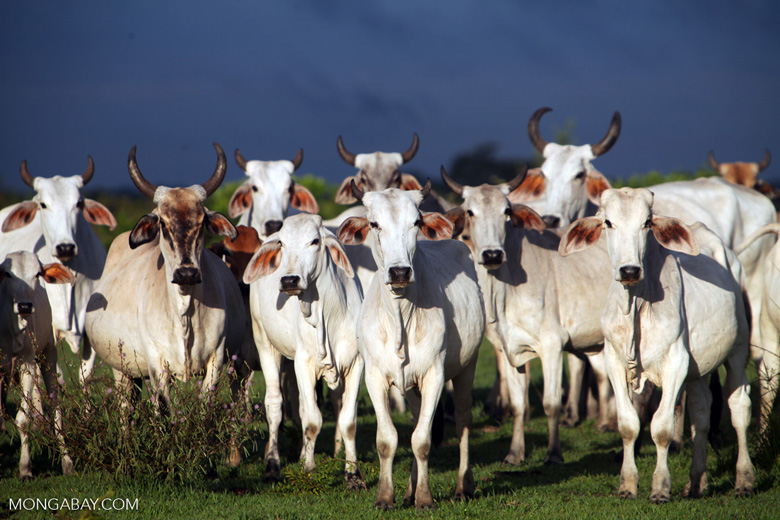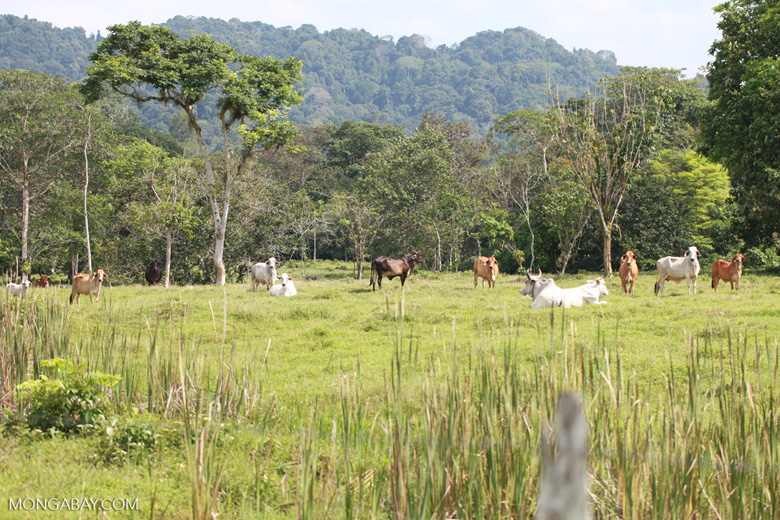According to a new report, the leading commercial cause of deforestation worldwide, ahead of soy, oil palm, and even logging, is beef production, and nowhere is this more evident than in Central America. A leading driver of forest loss there since the 1970s, cattle production at first centered on the most fertile lands in the region (volcanic and floodplain soils), which formerly had supported lush forests, but which provided good pasture once cleared. Driven by demand, the industry continued to expand into less-conducive areas, and by the mid-1990s was beginning to drive small-scale farmers and indigenous people off their lands to create further pasture land. These farmers in turn have increasingly cleared forests elsewhere in order to regain their lost livelihoods, often within protected forests.

While much of this activity is driven by the conventional ranching industry, there are many other players to consider, from international corporations to national governments, and even narco-traffickers, who make use of public lands in remote rural areas for moving their illicit products via networks of roads and makeshift aircraft landing strips. Untangling all of this to reveal a fuller picture of the many forces behind loss of tropical forests in the region for ranching will require a multipronged approach.
Mongabay.com therefore seeks story pitches for a series that will foster a better understanding of the scale, scope, and impact of cattle production on Central America’s forests and wildlife at the local to regional and national level, with a special interest in illegal ranching operations within some of the largest remaining forest blocks in Central America: Rio Platano Biosphere Reserve, Tawahka Biosphere Reserve, Patuca National Park, Bosawas Biosphere Reserve, Southeast Biosphere Reserve of Nicaragua, Maya Biosphere Reserve, and Darien National Park.
Topics of interest include but are not limited to:
- What illegal cattle production looks like in the largest remaining forest blocks in Central America: who are these ranchers, what are the impacts of their operations, and why are ranchers operating illegally in these protected areas?
- Answering the question of whether illegal and unsustainable beef is putting Central America’s economies at risk: the region’s herd of 18 million cattle is important for GDPs and livelihoods, but could the entire sector be undermined by illegal and unsustainable ranching?
- Tracking the fate of small-scale farmers who lose their land to large cattle operations and in turn clear protected forests to continue farming: what’s the impact on forests, rural communities, and biodiversity? Can we follow a displaced farmer to a tract of formerly uncut forest in Guatemala, for example, where this problem is currently on the increase?
- Investigating the degree to which illegal cattle ranching is tied to narco-trafficking in the region: how do illegal cattle operations provide a means for control of state lands and provide landing strips, trafficking routes, and money laundering services for drug cartels? How might addressing illegal “narco-ranching” bring back territorial control to rural border areas and help reverse deforestation?
- Illustrating the ways that Central America’s indigenous forest communities get caught in the crossfire of drug trafficking and cattle ranching: how do these activities undermine these communities’ ability to be stewards of the land and prevent agricultural incursions, including illegal clearing of forest for ranching, in their territories?
- How big businesses are involved: deforestation-free supply chains for beef are the stated objective of many companies, but what does this look like in reality? Are they living up to these goals? Some global brands have been linked to beef from Guatemala’s Laguna del Tigre National Park: can this be proven?
- The role that national governments play in promoting forest destruction by encouraging cattle production: as governments sign on to international treaties, receive foreign aid to conserve forests, and start projects to reduce emissions that cause climate change, are they complicit in the very destruction of the forests they purport to save by also promoting cattle production?
Related topics also of interest:
- The links between oil palm cultivation, illegal cattle ranching, and deforestation
- Examples of effective law enforcement actions like confiscation of cattle in protected areas and removal of illegal ranch infrastructure
- Following the path of a piece of beef from an unsustainable cattle operation to a resort town in coastal Mexico or similar areas
- Whether the “Alliance for Prosperity” investments meant to improve conditions in the region can be used to slow the drivers of deforestation for cattle production
- Solutions to the problem, from law enforcement to encouraging alternative protein sources for consumers and removal of agricultural subsidies or tax incentives in protected areas.
Mongabay will negotiate all fees and contracts on a per-story basis. Completed stories will be paid per word, depending on the journalist’s experience and the complexity of the reporting, and will be published on Mongabay.com and its Spanish language site Mongabay Latam, under an open Creative Commons license that allows for sharing and re-posting. We will also offer a small payment to journalists who proactively get their stories republished in major third-party print media outlets and on sites that draw more than 100,000 unique visitors per month.

Applications can be submitted in English or Spanish, and the final reporting will be published first in either English or Spanish and then translated to the other language by the Mongabay team.
Please submit your pitch here [opportunity now closed] along with your journalism resume. Pitches should be roughly 500 words in length. They should clearly explain the specific subject you would like to write about and your approach to covering it, describe a few potential sources, indicate if the topic involves any of the largest remaining forest blocks in Central America mentioned above, and say whether travel funding is necessary to complete the project (travel funds are available). Since this is an ongoing pitch solicitation, there is no deadline for submissions.
Consulte esta oportunidad y envíe su propuesta en español aquí.
Stories produced under this project – ENGLISH
Cattle ranching devours Nicaragua’s Bosawás Biosphere Reserve
by Michelle Carrere 10 March 2017
BOSAWÁS BIOSPHERE RESERVE, Nicaragua – To get to Napoleón’s house requires traveling on a gravel road near Siuna on a mule. It is the last dwelling before penetrating the core…
Cattle ranching threatens core of Biosphere Reserve of Southeast Nicaragua
by Wilder Pérez R. 27 March 2017
SOUTHEAST BIOSPHERE RESERVE, Nicaragua – The Biosphere Reserve of Southeast Nicaragua is bigger than countries like Qatar or Jamaica and shelters 526 species of birds—more species than can be found…
Guatemala issues red alert as national parks burn
by Sandra Cuffe 12 April 2017
The Guatemalan government issued a red alert for the Peten department Tuesday due to forest fires in national parks inside the Maya Biosphere Reserve. The biosphere reserve covers the northernmost…
A new secret runway found in Laguna del Tigre National Park in Guatemala
by Sebastián Escalón 18 May 2017
(Immediately after this collaborative report by Mongabay Latam and Guatemalan investigative news outlet Plaza Pública was published, government troops were deployed to destroy the runway) On the 26th of April, two…
Guatemalan authorities destroy secret airstrip in Laguna del Tigre National Park
by Sebastián Escalón 19 May 2017
(This is a collaborative article by Mongabay Latam and Plaza Pública, a Guatemalan investigative news outlet) The spokesperson for the Public Prosecutor’s Office, Julia Barrera, told Plaza Pública and Mongabay…
Panama: the ranching industry has moved into Darién National Park
by José Arcia 26 June 2017
DARIÉN PROVINCE, Panama – David Ramos’ ranch is in the community of Salodio, in Darién Province, in the eastern part of Panama. From there, one can observe Darién National Park,…
Extensive illegal cattle ranching destroys core area of Nicaragua’s Indio Maíz Biological Reserve
by Duyerling Ríos and Cristopher Mendoza 28 August 2017
(This article is a collaboration between Mongabay-Latam and Onda Local in Nicaragua) Indio Maíz Biological Reserve, Nicaragua – The howl of a spider monkey that swayed from branch to branch…
Nicaraguan beef raised illegally in biological reserve mostly exported
by Duyerling Ríos y Cristopher Mendoza 14 September 2017
(This article is a collaboration between Mongabay-Latam and Onda Local, read the first article here) Indio Maíz Biological Reserve, Nicaragua – “When I see my Chontaleños and Boaqueños (people from…
Illegal cattle ranching deforests Mexico’s massive Lacandon Jungle
by Rodrigo Soberanes 14 March 2018
The last thing on the minds of those who conduct their business on Mexico’s border with Guatemala is that cattle may be driving the destruction of the Lacandon Jungle, which…
Stories produced under this project – SPANISH
Ganadería y narcodeforestación: la lenta desaparición de los bosques en Centroamérica
por Mongabay Latam 31 marzo 2018
Desde la frontera “porosa” entre México y Guatemala hasta los bosques del Darién ubicados en los linderos de Panamá con Colombia, una peligrosa combinación amenaza la existencia de las áreas…
Ganado ilegal en México: las claves de la devastación en la Selva Lacandona
por Mongabay Latam 28 marzo 2018
Lo último que consideran quienes hacen negocios con ganado ilegal en México es que esta actividad acelera la deforestación en la Selva Lacandona. Al mexicano Carlos Rodríguez le iba bien…
Ganadería mortal: la actividad que devora los bosques de Bosawas
por Michelle Carrere (Carre.re) 22 febrero 2017
Unas cuantas horas en mula hacen falta para llegar, desde el camino ripiado en las cercanías de Siuna, a la casa de Napoleón. Es la última vivienda antes de penetrar…
Ganadería al límite: una actividad que ya ingresó al núcleo de la Reserva del Sureste de Nicaragua
por Wilder Pérez R. 8 marzo 2017
La Reserva de Biosfera del Sureste de Nicaragua es más extensa que países como Catar o Jamaica, alberga 526 especies de aves —más que las que reúnen las 50 naciones…
Guatemala en alerta roja por los incendios en parques nacionales
por Sandra Cuffe 13 abril 2017
El gobierno de Guatemala declaró la alerta roja en el departamento de El Petén el martes debido a los incendios forestales en parques nacionales dentro de la Reserva de la…
Guatemala: autoridades destruyen la pista clandestina hallada en el Parque Nacional Laguna del Tigre
por Sebastián Escalón 17 mayo 2017
(Este artículo es una colaboración periodística entre Mongabay Latam y Plaza Pública) Julia Barrera, vocera del Ministerio Público, informó el lunes a Plaza Pública y Mongabay Latam, que habían detectado una…
Guatemala: detectan nueva pista de aterrizaje clandestina en el Parque Nacional Laguna del Tigre
por Sebastián Escalón 15 mayo 2017
(Este artículo es una colaboración periodística entre Mongabay Latam y Plaza Pública de Guatemala) El 26 de abril, dos reporteros sobrevolaron el Parque Nacional Laguna del Tigre, ubicado en el municipio…
Panamá: la ganadería ha ingresado al Parque Nacional Darién
por José Arcia 7 mayo 2017
La finca de David Ramos queda en la comunidad de Salodio, en la provincia de Darién, zona oriental de Panamá, y desde allí se puede observar el Parque Nacional Darién,…
Ganadería extensiva e ilegal destruye Reserva Indio Maíz en Nicaragua
por Duyerling Ríos y Cristopher Mendoza 14 julio 2017
(Este artículo es una colaboración periodística entre Mongabay Latam y Onda Local de Nicaragua) El gruñido de un mono araña que se balancea de rama en rama alertó nuestra presencia a un grupo de lapas…
Nicaragua: ¿a dónde va el ganado que introducen en la Reserva Indio Maíz?
por Duyerling Ríos y Cristopher Mendoza 15 agosto 2017
(Este artículo es una colaboración periodística entre Mongabay Latam y Onda Local de Nicaragua) “Cuando veo a mis coterráneos chontaleños y boaqueños quemando bosques, sembrando pasto, les preguntó, ¿cuál es el beneficio si tienen que…
México: tráfico ilegal de ganado y deforestación en la Selva Lacandona
por Rodrigo Soberanes 19 febrero 2018
Lo último que consideran quienes hacen negocios en la frontera de Guatemala y México es que el ganado acelera la deforestación en la selva Lacandona. Al campesino mexicano Carlos Rodríguez…